The process of producing recombinant mouse IL13 in mammalian cells involves co-inserting the target gene that encodes the 22-131aa of mouse IL13 into an expression plasmid with a C-terminal 6xHis-tag gene, which is transformed into mammalian cells. These cells are cultured to produce the mouse IL13 protein. The cells are lysed to release the protein, which is purified using affinity chromatography. The purity of the recombinant mouse IL13 protein is determined using SDS-PAGE, exceeding 95%. Its endotoxin is less than 1.0 EU/μg as determined by the LAL method. The activity of the IL13 protein is measured in a cell proliferation assay using TF‑1 human erythroleukemic cells, with the ED50 of 11.34 ng/ml.
IL13 is a pleiotropic cytokine. It can promote alternative activation of microglia and macrophages after stroke [1]. It shows potential for chimeric antigen receptor (CAR) T cell therapy for glioblastoma [2]. It protects the intestine from ischemia and reperfusion injury [3]. IL13 also promotes metaplasia development during chronic gastritis [4] and regulates secretion in airway epithelial cells through autophagy [5]. Furthermore, IL13 has been implicated in cardiac regeneration processes in mice [6]. Research has found that IL13 limits microgliosis, oligodendrocyte loss, and demyelination in a mouse model of demyelinating disease [7]. IL13 is linked to various diseases, such as eosinophilic esophagitis [8], colorectal tumors post-pelvic radiotherapy [9], asthma [10], and polycystic kidney disease [11].
References:
[1] S. Taj, D. Blon, C. Hoornaert, J. Daans, A. Quarta, J. Praetet al., Targeted intracerebral delivery of the anti-inflammatory cytokine il13 promotes alternative activation of both microglia and macrophages after stroke, Journal of Neuroinflammation, vol. 15, no. 1, 2018. https://doi.org/10.1186/s12974-018-1212-7
[2] R. Starr, B. Aguilar, D. Gumber, M. Maker, S. Huard, D. Wanget al., Inclusion of 4-1bb costimulation enhances selectivity and functionality of il13rα2-targeted chimeric antigen receptor t cells, Cancer Research Communications, vol. 3, no. 1, p. 66-79, 2023. https://doi.org/10.1158/2767-9764.crc-22-0185
[3] D. Farmer, B. Ke, X. Shen, F. Kaldas, F. Gao, M. Watsonet al., Interleukin-13 protects mouse intestine from ischemia and reperfusion injury through regulation of innate and adaptive immunity, Transplantation, vol. 91, no. 7, p. 737-743, 2011. https://doi.org/10.1097/tp.0b013e31820c861a
[4] C. Noto, S. Hoft, K. Bockerstett, N. Jackson, E. Ford, L. Vestet al., Il13 acts directly on gastric epithelial cells to promote metaplasia development during chronic gastritis, Cellular and Molecular Gastroenterology and Hepatology, vol. 13, no. 2, p. 623-642, 2022. https://doi.org/10.1016/j.jcmgh.2021.09.012
[5] J. Dickinson, Y. Alevy, N. Malvin, K. Patel, S. Gunsten, M. Holtzmanet al., Il13 activates autophagy to regulate secretion in airway epithelial cells, Autophagy, vol. 12, no. 2, p. 397-409, 2016. https://doi.org/10.1080/15548627.2015.1056967
[6] C. O’Meara, J. Wamstad, R. Gladstone, G. Fomovsky, V. Butty, A. Shrikumaret al., Transcriptional reversion of cardiac myocyte fate during mammalian cardiac regeneration, Circulation Research, vol. 116, no. 5, p. 804-815, 2015. https://doi.org/10.1161/circresaha.116.304269
[7] D. Blon, C. Guglielmetti, C. Hoornaert, A. Quarta, J. Daans, D. Dooleyet al., Intracerebral transplantation of interleukin 13-producing mesenchymal stem cells limits microgliosis, oligodendrocyte loss and demyelination in the cuprizone mouse model, Journal of Neuroinflammation, vol. 13, no. 1, 2016. https://doi.org/10.1186/s12974-016-0756-7
[8] M. Rothenberg, Molecular, genetic, and cellular bases for treating eosinophilic esophagitis, Gastroenterology, vol. 148, no. 6, p. 1143-1157, 2015. https://doi.org/10.1053/j.gastro.2015.02.002
[9] G. Li, A. Wu, D. Qi, F. Cui, Y. Zeng, F. Xieet al., Differential effects of peptidoglycan on colorectal tumors and intestinal tissue post-pelvic radiotherapy, Oncotarget, vol. 7, no. 46, p. 75685-75697, 2016. https://doi.org/10.18632/oncotarget.12353
[10] D. Symula, K. Frazer, Y. Ueda, P. Denèfle, M. Stevens, Z. Wanget al., Functional screening of an asthma qtl in yac transgenic mice, Nature Genetics, vol. 23, no. 2, p. 241-244, 1999. https://doi.org/10.1038/13880
[11] E. Olsan, S. Mukherjee, B. Wulkersdorfer, J. Shillingford, A. Giovannone, G. Todorovet al., Signal transducer and activator of transcription-6 (stat6) inhibition suppresses renal cyst growth in polycystic kidney disease, Proceedings of the National Academy of Sciences, vol. 108, no. 44, p. 18067-18072, 2011. https://doi.org/10.1073/pnas.1111966108






